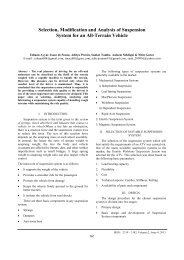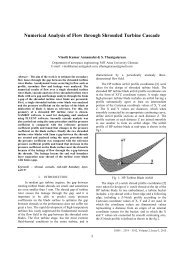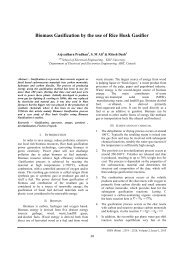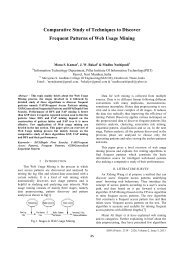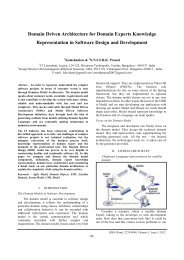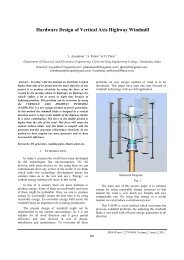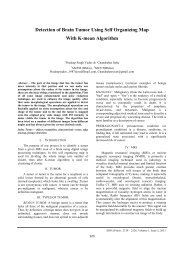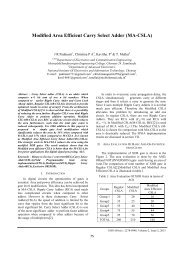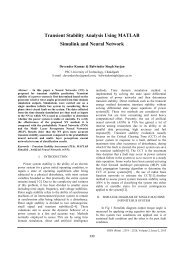Cost Effective Selection of Data Center in Cloud ... - IRD India
Cost Effective Selection of Data Center in Cloud ... - IRD India
Cost Effective Selection of Data Center in Cloud ... - IRD India
Create successful ePaper yourself
Turn your PDF publications into a flip-book with our unique Google optimized e-Paper software.
Special Issue <strong>of</strong> International Journal on Advanced Computer Theory and Eng<strong>in</strong>eer<strong>in</strong>g (IJACTE)migration <strong>of</strong> virtual mach<strong>in</strong>es. A load balanc<strong>in</strong>g modelis designed and implemented to reduce virtualmach<strong>in</strong>es’ migration time by shared storage, to balanceload amongst servers accord<strong>in</strong>g to their processor or IOusage, etc. and to keep virtual mach<strong>in</strong>es’ zero-downtime<strong>in</strong> the process. A distributed load balanc<strong>in</strong>g algorithmCOMPARE AND BAL-ANCE is also proposed that isbased on sampl<strong>in</strong>g and reaches equilibrium very fast.This algorithm assures that the migration <strong>of</strong> VMs isalways from high-cost physical hosts to low-cost hostbut assumes that each physical host has enough memorywhich is a weak assumption.E. Event-drivenV. Nae et al. presented an event-driven loadbalanc<strong>in</strong>g algorithm for real-time Massively MultiplayerOnl<strong>in</strong>e Games (MMOG). This algorithm after receiv<strong>in</strong>gcapacity events as <strong>in</strong>put, analyzes its components <strong>in</strong>context <strong>of</strong> the resources and the global state <strong>of</strong> the gamesession, thereby generat<strong>in</strong>g the game session loadbalanc<strong>in</strong>g actions. It is capable <strong>of</strong> scal<strong>in</strong>g up and down agame session on multiple resources accord<strong>in</strong>g to thevariable user load but has occasional QoS breaches.Metrics for Load Balanc<strong>in</strong>g In <strong>Cloud</strong>sVarious metrics considered <strong>in</strong> exist<strong>in</strong>g loadbalanc<strong>in</strong>g techniques <strong>in</strong> cloud comput<strong>in</strong>g are discussedbelowThroughput is used to calculate the no. <strong>of</strong> tasks whoseexecution has been completed. It should be high toimprove the performance <strong>of</strong> the system.Overhead Associated determ<strong>in</strong>es the amount <strong>of</strong>overhead <strong>in</strong>volved while implement<strong>in</strong>g a load-balanc<strong>in</strong>galgorithm. It is composed <strong>of</strong> overhead due to movement<strong>of</strong> tasks, <strong>in</strong>ter-processor and <strong>in</strong>ter-processcommunication. This should be m<strong>in</strong>imized so that a loadbalanc<strong>in</strong>g technique can work efficiently.Fault Tolerance is the ability <strong>of</strong> an algorithm to performuniform load balanc<strong>in</strong>g <strong>in</strong> spite <strong>of</strong> arbitrary node or l<strong>in</strong>kfailure. The load balanc<strong>in</strong>g should be a good faulttoleranttechnique.Migration time is the time to migrate the jobs orresources from one node to other. It should bem<strong>in</strong>imized <strong>in</strong> order to enhance the performance <strong>of</strong> thesystem.Response Time is the amount <strong>of</strong> time taken to respondby a particular load balanc<strong>in</strong>g algorithm <strong>in</strong> a distributedsystem. This parameter should be m<strong>in</strong>imized.Resource Utilization is used to check the utilization <strong>of</strong>re-sources. It should be optimized for an efficient loadbalanc<strong>in</strong>g.Performance is used to check the efficiency <strong>of</strong> thesystem. This has to be improved at a reasonable cost,e.g., reduce task response time while keep<strong>in</strong>g acceptabledelays.IV. INTRODUCTION TO CLOUD ANALYSTGUI Package - It is responsible for the graphical user<strong>in</strong>terface, and acts as the front end controller for theapplication, manag<strong>in</strong>g screen transitions and other UIactivities.Simulation - This component is responsible for hold<strong>in</strong>gthe simulation parameters, creat<strong>in</strong>g and execut<strong>in</strong>g thesimulation.UserBase - This component models a user base andgenerates traffic represent<strong>in</strong>g the users.<strong>Data</strong><strong>Center</strong>Controller - This component controls thedata center activities.Internet - This component models the Internet andimplements the traffic rout<strong>in</strong>g behavior.InternetCharacteristics - This component ma<strong>in</strong>ta<strong>in</strong>s thecharacteristics <strong>of</strong> the Internet dur<strong>in</strong>g the simulation,<strong>in</strong>clud<strong>in</strong>g the latencies and available bandwidthsbetween regions, the current traffic levels, and currentperformance level <strong>in</strong>formation for the data centers.VmLoadBalancer - This component models the loadbalance policy used by data centers when serv<strong>in</strong>gallocation requests. Default load balanc<strong>in</strong>g policy uses around rob<strong>in</strong> algorithm, which allocates all <strong>in</strong>com<strong>in</strong>grequests to the available virtual mach<strong>in</strong>es <strong>in</strong> round rob<strong>in</strong>fashion without consider<strong>in</strong>g the current load on eachvirtual mach<strong>in</strong>e. Additionally, it is possible application<strong>of</strong> a throttled load balanc<strong>in</strong>g policy that limits thenumber <strong>of</strong> requests be<strong>in</strong>g processed <strong>in</strong> each virtualmach<strong>in</strong>e to a throttl<strong>in</strong>g threshold. If requests arereceived caus<strong>in</strong>g this threshold to be exceeded <strong>in</strong> allavailable virtual mach<strong>in</strong>es, then the requests are queueduntil a virtual mach<strong>in</strong>e becomes available.<strong>Cloud</strong>AppServiceBroker This component models theservice brokers that handle traffic rout<strong>in</strong>g between userbases and data centers. The default traffic rout<strong>in</strong>g policyis rout<strong>in</strong>g traffic to the closest data center <strong>in</strong> terms <strong>of</strong>network latency from the source user base.V. PERFORMANCE ANALYSISWe had used the cloud analyst tool to evaluate thealgorithms round rob<strong>in</strong>, and throttled algorithm for thecase closest data center by us<strong>in</strong>g g user base (1-3) withdifferent regions & data centers (1-4) with differentvirtual mach<strong>in</strong>e monitors.3ISSN (Pr<strong>in</strong>t) : 2319 – 2526, Volume-2, Issue-1, 2013
Special Issue <strong>of</strong> International Journal on Advanced Computer Theory and Eng<strong>in</strong>eer<strong>in</strong>g (IJACTE)A. User BaseThe design model use the user base to represent thes<strong>in</strong>gle user but ideally a user base should be used torepresent a large numbers <strong>of</strong> users for efficiency <strong>of</strong>simulation.VI. RESULTB. <strong>Data</strong>centerFig. 3 : Simulation Configuration<strong>Data</strong>center manages the data management activitiesvirtual mach<strong>in</strong>es creation and destruction and does therout<strong>in</strong>g <strong>of</strong> user requests received from user base via the<strong>in</strong>ternet to virtual mach<strong>in</strong>es.After perform<strong>in</strong>g the simulation the result computedby cloud analyst is shown <strong>in</strong> follow<strong>in</strong>g below figures.We have used the above def<strong>in</strong>ed configuration for eachload balanc<strong>in</strong>g policy one by one and depend<strong>in</strong>g(Response Time and Process<strong>in</strong>g <strong>Cost</strong> Us<strong>in</strong>g RoundRob<strong>in</strong>)4ISSN (Pr<strong>in</strong>t) : 2319 – 2526, Volume-2, Issue-1, 2013
Special Issue <strong>of</strong> International Journal on Advanced Computer Theory and Eng<strong>in</strong>eer<strong>in</strong>g (IJACTE)VIII. REFERENCES(Response Time and Process<strong>in</strong>g <strong>Cost</strong> Us<strong>in</strong>g Throttled )Fig. 4 : Comparison <strong>of</strong> Load Balanc<strong>in</strong>g Algorithm)Compar<strong>in</strong>g with the table and graph, overallresponse time and data centre process<strong>in</strong>g time isimproved. It is also seen that the virtual mach<strong>in</strong>e costand data transfer time <strong>in</strong> the round rob<strong>in</strong> algorithm ismuch better when compared to throttled algorithms.VII. CONCLUSIONSThe response time and data transfer cost is achallenge <strong>of</strong> every cloud eng<strong>in</strong>eer to build up theproducts that can <strong>in</strong>crease the bus<strong>in</strong>ess performance <strong>in</strong>the cloud <strong>in</strong>dustry adopted sector. Several strategies lackefficient schedul<strong>in</strong>g and load balanc<strong>in</strong>g resourceallocation techniques lead<strong>in</strong>g to <strong>in</strong>creased operationalcost and give customer dissatisfaction. The paper tries togive a bird’s eye view on enhanced strategies throughimproved job and load balanc<strong>in</strong>g resource allocationtechniques.[1] Anthony T.Velte, Toby J.Velte, Robert Elsenpeter,<strong>Cloud</strong> Comput<strong>in</strong>g A Practical Approach, TATAMcGRAW-HILL Edition 2010.[2] Bhathiya, Wickremas<strong>in</strong>ghe. <strong>Cloud</strong> Analyst: A <strong>Cloud</strong>Sim-based Visual Modeller for Analys<strong>in</strong>g <strong>Cloud</strong>Comput<strong>in</strong>g Environments and Applications[3] Chhabra, G. S<strong>in</strong>gh, Qualitative Parametric Comparison<strong>of</strong> Load Balanc<strong>in</strong>g Algorithms <strong>in</strong> DistributedComput<strong>in</strong>g Environment,14th International Conferenceon Advanced Comput<strong>in</strong>g and Communication, July2006 IEEE, pp 58 – 61.[4] Fang Y., Wang F. and Ge J. (2010) Lecture Notes <strong>in</strong>Comput-er Science, 6318, 271-277.[5] Hu J., Gu J., Sun G. and Zhao T. (2010) 3rdInternational Symposium on Parallel Architectures,Algorithms and Pro-gramm<strong>in</strong>g, 89-96.[6] Mehta H., Kanungo P. and Chandwani M. (2011)International Conference Workshop on Emerg<strong>in</strong>gTrends <strong>in</strong> Technology, 370-375[7] Nae V., Prodan R. and Fahr<strong>in</strong>ger T. (2010) 11thIEEE/ACM International Conference on GridComput<strong>in</strong>g (Grid), 9-17.[8] Ram Prasad Padhy (107CS046), P Goutam Prasad Rao(107CS039).Load balanc<strong>in</strong>g <strong>in</strong> cloud comput<strong>in</strong>gsystem Department <strong>of</strong> Computer Science andEng<strong>in</strong>eer<strong>in</strong>g National Institute <strong>of</strong> Technology,Rourkela Rourkela-769 008, Orissa, <strong>India</strong> May, 2011.[9] Randles M., Lamb D. and Taleb-Bendiab A. (2010)24th Inter-national Conference on AdvancedInformation Network<strong>in</strong>g and Applications Workshops,551-556[10] T.R.Gopalakrishnan Nair Vaidehi .M2 Suma. VImproved Strategies for Enhanced Bus<strong>in</strong>essPerformance <strong>in</strong> <strong>Cloud</strong> based IT Industries, Research &Industry Incubation Centre, DSI, Bangalore, <strong>India</strong>.[11] Wenhong Tian, Yong Zhao, Yuanliang Zhong,M<strong>in</strong>xian Xu, Chen J<strong>in</strong>g(2011) , A Dynamic AndIntegrated Load balanc<strong>in</strong>g Schedul<strong>in</strong>g Algorithm For<strong>Cloud</strong> <strong>Data</strong>centers, University <strong>of</strong> Electronic Scienceand Technology[12] Zhao Y. and Huang W. (2009) 5th International Jo<strong>in</strong>tConfer-ence on INC, IMS and IDC, 170-175.5ISSN (Pr<strong>in</strong>t) : 2319 – 2526, Volume-2, Issue-1, 2013



